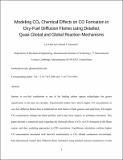| dc.contributor.author | Chen, Lei | |
| dc.contributor.author | Ghoniem, Ahmed F. | |
| dc.date.accessioned | 2015-08-25T19:17:07Z | |
| dc.date.available | 2015-08-25T19:17:07Z | |
| dc.date.issued | 2014-01 | |
| dc.date.submitted | 2013-10 | |
| dc.identifier.issn | 0010-2202 | |
| dc.identifier.issn | 1563-521X | |
| dc.identifier.uri | http://hdl.handle.net/1721.1/98227 | |
| dc.description.abstract | Interest in oxy-fuel combustion as one of the leading carbon capture technologies has grown significantly in the past two decades. Experimental studies have shown higher CO concentration in oxy-fuel diffusion flames than in traditional air-fuel flames of both gaseous and solid fuels. The higher CO concentration changes the flame profiles, and it may have impacts on pollutants formation. This article presents a numerical study regarding the chemical effects of CO[subscript 2] on CO formation in the flame region, and their modeling approaches in CFD simulations. Equilibrium calculation confirms higher CO concentration associated with fuel-rich stoichiometry in CO[subscript 2] diluted combustion environment. One-dimensional counter-flow diffusion flame simulation using detailed reaction mechanisms reveals that the reaction H + CO[subscript 2] OH + CO enhances CO formation in the presence of high CO[subscript 2] concentration, leading to a significantly higher CO concentration under oxy-fuel combustion conditions. High CO[subscript 2] concentration also impacts the reaction OH + H[subscript 2] H + H[subscript 2]O via OH radical and results in lower H[subscript 2] and higher H[subscript 2]O concentrations in the flame profile. Computational fluid dynamics (CFD) simulations of a swirling diffusion flame under air-fired and oxy-fuel conditions were conducted using the eddy dissipation model and the eddy dissipation concept model with quasi-global and global kinetic mechanisms. Results show that reasonable CO predictions can only be obtained using finite-rate approach with appropriate mechanisms considering the CO[subscript 2] chemical effects. The Westbrook–Dryer two-step mechanism consistently underestimates the CO concentrations. In contrast, the Westbrook–Dryer multiple-step mechanism captures the chemical effects of CO[subscript 2], and improves the predictions. | en_US |
| dc.description.sponsorship | Clean Energy Research Program at MIT and ENEL | en_US |
| dc.language.iso | en_US | |
| dc.publisher | Taylor & Francis | en_US |
| dc.relation.isversionof | http://dx.doi.org/10.1080/00102202.2014.883384 | en_US |
| dc.rights | Creative Commons Attribution-Noncommercial-Share Alike | en_US |
| dc.rights.uri | http://creativecommons.org/licenses/by-nc-sa/4.0/ | en_US |
| dc.source | Prof. Ghoniem via Angie Locknar | en_US |
| dc.title | Modeling CO[subscript 2] Chemical Effects on CO Formation in Oxy-Fuel Diffusion Flames Using Detailed, Quasi-Global, and Global Reaction Mechanisms | en_US |
| dc.type | Article | en_US |
| dc.identifier.citation | Chen, Lei, and Ahmed F. Ghoniem. “Modeling CO[subscript 2] Chemical Effects on CO Formation in Oxy-Fuel Diffusion Flames Using Detailed, Quasi-Global, and Global Reaction Mechanisms.” Combustion Science and Technology 186, no. 7 (May 28, 2014): 829–848. | en_US |
| dc.contributor.department | Massachusetts Institute of Technology. Department of Mechanical Engineering | en_US |
| dc.contributor.mitauthor | Ghoniem, Ahmed F. | en_US |
| dc.contributor.mitauthor | Chen, Lei | en_US |
| dc.relation.journal | Combustion Science and Technology | en_US |
| dc.eprint.version | Author's final manuscript | en_US |
| dc.type.uri | http://purl.org/eprint/type/JournalArticle | en_US |
| eprint.status | http://purl.org/eprint/status/PeerReviewed | en_US |
| dspace.orderedauthors | Chen, Lei; Ghoniem, Ahmed F. | en_US |
| dc.identifier.orcid | https://orcid.org/0000-0001-8730-272X | |
| mit.license | OPEN_ACCESS_POLICY | en_US |
| mit.metadata.status | Complete | |
